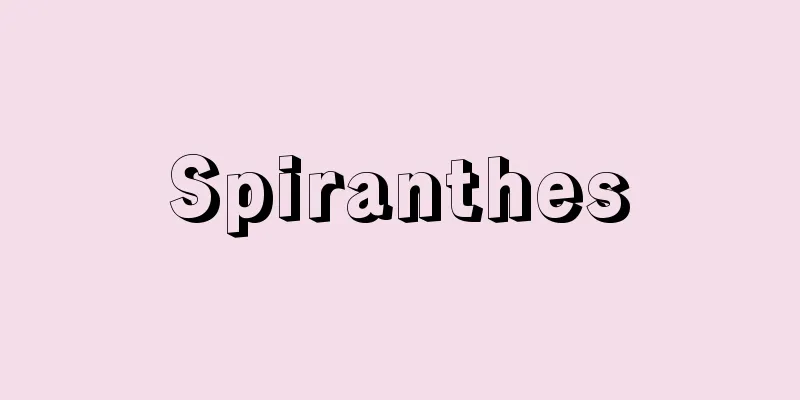Clothing - Ifuku

|
A general term for clothing worn by humans, excluding headgear, footwear, gloves, etc. "Clothes." Clothing only functions when worn by a human. By investigating the relationship between clothing and humans, the performance required of clothing has become clear. In doing so, an interdisciplinary method is used that includes not only materials science and composition science, but also physiology, chemistry, ergonomics, aesthetics, and psychology. This is because clothing is deeply connected not only to the outside of humans, but also to their insides. [Masumi Tsuji] Clothing MaterialsClothing materials are selected based on the type and purpose of the clothing. Common clothing materials are natural and chemical fibers, but recently, by mixing fibers, many materials have been developed with new properties. For example, mixing polyester with cotton or wool improves the appearance and feel, increases durability, and makes washing easier. Similarly, mixing acrylic with wool increases heat retention and allows for pleating. Nylon and vinylon are often mixed into school uniforms and work clothes because of their remarkable durability. The performance of a mixed item does not necessarily correspond to the addition or subtraction of the performance values of the fibers mixed in. This is because it is affected by the weave structure and thread thickness. In addition, the following processing methods are used to give the fibers special properties: (1) Fiber with irregular cross section This is a method of changing the shape of the nozzle holes to make the fiber cross section irregular, such as triangular or cross-shaped, which not only gives it flexibility, beautiful luster, and deep color, but also has the effect of making it invisible even on thin fabrics due to diffuse reflection. It is also possible to make the fiber hollow to resemble cotton or linen, adding lightness, warmth, and softness. (2) Composite fiber: This fiber is made by bonding two different types of raw materials together, and the difference in their shrinkage caused by heat can be used to create shrinkage. (3) Bulking process: Thermoplasticity is utilized to give the fabric a crimped appearance. (4) Wrinkle-resistant processing (resin processing) (8) Flame retardant processing (fire retardant processing) (11) Opal processing: One side of the interwoven fibers is dissolved in acid to create a lace-like pattern. (12) Flocking As described above, materials can be processed to turn them into luxury items by covering up their defects or changing their texture. Artificial leather has also been developed that has a structure similar to that of natural leather by intertwining ultra-fine fibers. [Masumi Tsuji] Clothing and the human bodyWhen wearing clothes, the relationship between the clothes and the human body is important in terms of the clothing's mobility function and its ability to transfer heat, moisture, and air; all of these are important factors that determine the comfort of the clothes. [1] Mobility function This refers to the effect of clothing deforming due to deformation of the human body caused by movement, restricting and compressing the human body, and inhibiting movement. The amount of slack in clothing is related to deformation, but the parts that cannot be covered by the amount of slack will be stretched by the clothing material and compress the human body. The amount of skin stretch is a reference for determining the amount of slack, but the actual movement of the human body is complex and is affected by the stretchability and friction properties of the clothing material, so clothing design must incorporate these variables. Deformation and compression can sometimes be eliminated by materials, but they can also be corrected by structural means such as the shape of the curves, the amount and position of darts, and the position of seams, which will affect the silhouette and design of the appearance. The amount of separation between which parts and the body is required to be scientifically rational, as well as to have a beautiful appearance and conform to fashion. [2] Heat, moisture, and air transfer function This is related to the human body's thermoregulation function. Clothing creates a unique clothing climate between the outside world and the skin, releasing heat from inside the body to the outside world and also transmitting changes in the temperature and humidity of the outside world to the skin. Heat is dissipated by radiation, convection, and conduction, and the moisture permeability, breathability, water absorption, and heat retention of the clothing material become important in this process. Changes in the surface shape of the fibers due to moisture and water absorption affect the feel against the skin, but since ventilation between the air underneath the clothing and the outside air through openings is also added, the design of the openings must also be taken into consideration. This field is related to the thermal balance between people, clothing, and the environment. As described above, in the relationship between clothing and the human body, it is important to clarify how the physical properties of clothing materials, clothing design, and comfort are related to each other. In particular, the sensual aspect of comfort is more influenced by the psychological function of the garment, which is the desire to look beautiful, than by the rational function of clothing, making evaluation of it complicated. [Masumi Tsuji] Care of clothingEveryday care, such as washing, ironing, and storage, is related to the degree to which clothing deteriorates. Washing causes clothes to deteriorate, leading to deformation, changes in texture, fuzzing, and yellowing. Deformation is affected by the shrinkage, wrinkle resistance, and elasticity of the material, the density of the weave, the sewing, and the auxiliary materials. Weaves with loose twists and coarse densities are prone to shrinkage, and even if processed, deformation due to washing can occur. When sewing, the performance of the sewing thread and thread adjustment can cause the seams to pull or become distorted, and auxiliary materials such as linings and interlinings can harden and shrink. Changes in texture and fuzzing affect the sense of sight and touch, strengthening the impression of deterioration. Yellowing can be caused by re-soiling, sunlight, or iron in tap water. Furthermore, the strength of fabric decreases due to the mechanical action of the washing machine, soaking in detergent or bleach, exposure to sunlight, and the heat of an iron. Clothing stored in storage is subject to humidity, causing discoloration, embrittlement, and mold, and when mixed with mothballs, buttons and other parts can dissolve. Although it depends on the expected service life, the deterioration of clothing is accelerated by the above-mentioned handling process, and complaints from consumers are likely to occur at this stage. It is important for manufacturers to use appropriate materials and sewing methods, and for users to handle the clothing appropriately. [Masumi Tsuji] Clothing and SocietyWhen it comes to clothing, there are voluntary regulations on the part of manufacturers, such as quality standards and size standards, as well as laws aimed at protecting consumers, such as the Household Products Quality Labeling Act and safety laws. [Masumi Tsuji] Quality StandardsThe JIS (Japanese Industrial Standards) prescribes the quality assessment criteria and testing methods for textile products, and quality standards based on these are set by various inspection agencies, department stores, etc. Product tests carried out at various places are also based on the JIS, but accidents caused by actual wear are often caused by a combination of complex factors, so test methods that are more suited to practical use are also used. [Masumi Tsuji] Size StandardOn March 1, 1980, new "General Rules for Sizes and Labeling of Ready-Made Clothing Products" were published. The previous JIS nominal sizes published in 1970 had problems such as inadequate basic data and inconsistent product sizes, and a revision was necessary to align with international standards. The new size standards divide wearers into five groups: infants, boys, girls, adult men, and adult women, and divide the wearing categories into full body clothing, upper body clothing, and lower body clothing, with basic body measurements determined accordingly. Two types of display methods are permitted: a list of dimensions and pictorial display. For infants and toddlers, age in months has been abolished, and there are seven sizes with height and weight as the basic body measurements. For boys and girls, there are three body types, Y, A, and B, which are divided into those that require a tight fit and those that do not, with the former displaying height and chest circumference, and the latter only displaying height. For lower body clothing, boys' body types are waist circumference, and girls' body types are hip circumference. For adult men, body types are divided into seven types, Y, YA, A, AB, B, BE, and E, and for adult women, four types, Y, A, AB, and B, with those that require a tight fit being displayed in the order of chest circumference, waist circumference (for girls, waist circumference), and height, and those that do not require a tight fit being displayed in the order of chest circumference and height. For adult height, the designation number may be entered instead of the measurement value. If other body part measurements are added, they are entered below the line. [Masumi Tsuji] Household Goods Quality Labeling ActThe law was promulgated in May 1962 and has undergone numerous revisions to reach its current form. The purpose of the law is to ensure proper labeling of quality and to protect the interests of general consumers, and it applies to 39 textile products (as of March 1980). There are six items that must be labeled: (1) fiber composition, (2) shrinkage, (3) flame retardancy, (4) home washing instructions and other handling instructions, (5) water repellency, and (6) size indication. Penalties are imposed for any improper labeling. The items that must be labeled vary depending on the type of product, but for clothing, fiber composition and handling instructions must be indicated, and coats must also indicate water repellency. Shrinkage rate and size indication are required for curtains, sheets, futon covers, etc. Fiber composition is indicated by the name of the fiber and the blend ratio, along with the name of the labeler. Blend ratios are expressed in percentage order, with all the fibers allowed to be indicated together if they are less than 10%. In 1976, "pictorial handling instructions" were established for home washing instructions and other handling instructions, and labels with pictorial indications are to be attached directly to the product. According to the JIS testing method, water repellency is only indicated for products with a water repellency level (degree of water repelling, waterproof effect) of 70 points or above, but if the effect decreases after washing or dry cleaning, this must be clearly indicated. Even though the labeling law has been implemented, there are problems with incorrect labeling of blend ratios, excessive labeling of washing instructions, and inadequate labeling, which is common in imported products. In addition, there are many complaints about color fading, so there is an increasing need to display color fastness, and there are hopes that size labeling will also be made mandatory under the Quality Labeling Law. Another mandatory labeling is the country of origin. There are many misleading labels on imported goods and branded goods, but misleading labels are regulated by the Fair Trade Commission's Unfair Premiums and Misrepresentations Prevention Act. The country of origin for clothing is the name of the country where the product was sewn, and in the case of design collaboration, this must also be clearly stated. Further voluntary markings include the Woolmark, which is managed by the International Wool Secretariat, and demerit marks, which indicate weaknesses of a product. [Masumi Tsuji] Safety LawsProblems of skin disorders, toxicity and carcinogenicity caused by processing agents for textile products came into question, and the "Law Concerning the Control of Household Products Containing Harmful Substances" was enacted in 1973. In 1975, the use of organic mercury compounds was banned, and the resin processing agent formaldehyde was regulated, followed in 1978 by restrictions on the insect repellent processing agent dieldrin and the use of flame retardant processing agents such as trisphosphate. Testing of new types of processing agents was also carried out one after another, and regulations and bans were announced. [Masumi Tsuji] The original meaning of clothingClothing, along with food and shelter, is one of the most basic necessities of human life. Moreover, humans are the only animals that wear clothes, so clothing can be said to be a form of adaptation for humans in a broad sense. Clothing can be broadly divided into two aspects. The first is clothing that protects the body, seen in adapting to the natural environment. Clothing has the function of protecting the body from heat, cold, light, moisture, wind, and external forces. The second aspect is that of cultural customs. In this sense, clothing is related to aesthetic sensibility as a means of decoration, and, backed by a social background, plays a role as an indicator of status, gender, and ethnicity, or as a ritual sign. The second aspect goes beyond the basic necessity of clothing to protect the body, and is based on the distinction that people make from others, whether by wearing or not wearing clothing. The latter is related to shame, especially in sexual situations. Clothing that protects the body has helped humans to face harsh natural environments and contributed to the expansion of human habitation. For example, the clothing culture of the Eskimos is adapted to cold regions, and the clothing of desert nomads protects them from strong sunlight and dust. In addition, armor for battle and wetsuits for diving can be said to have been specially developed for this function. On the other hand, clothing as customs can be classified according to the purpose for which it is worn. First, there is clothing for decoration. Many ethnic groups have a desire for beauty, although the standards differ, and this insatiable pursuit and awareness has led to the diversification of clothing along with fashion. Second, there is clothing that symbolizes social status or position or is an indicator of wealth. Third, there is clothing that recognizes one's belonging to a certain group or category when worn. Examples include uniforms, military uniforms, and national costumes, and also includes clothing that indicates differences in age and marital status. Wearing such clothing not only indicates one's belonging to one's own group, but also makes it clear that one is different from other groups. Fourth, there is clothing that is a sign that highlights the importance of rituals. In religious rituals, annual rituals, and rites of passage in life rituals, it is not uncommon to see unusual clothing that is different from everyday clothing. Clothing as customs as described above varies from ethnic group to ethnic group, and is deeply connected to the traditions that each ethnic group has cultivated. Some researchers focus on this point and analyze the symbolic function of clothing. [Norio Takaya] "Textile Product Consumption Science Handbook" edited by the Japan Society for the Science of Textile Products Consumption (1975, Koseikan) " ▽ "Textile Product Consumption Science General Theory" edited and published by the Japan Society for the Science of Textile Products Consumption (1977) ▽ "JIS Clothing Size Promotion Council edited and published "All about Ready-made Clothing Sizes" (1980) ▽ "Japan Consumer Association edited and published "Explanation of the Household Products Quality Labeling Law" (1977)" [Reference item] | | |©Shogakukan "> Basic Performance of Clothing ©Shogakukan "> Characteristics and uses of various fibers (1) Natural fibers ©Shogakukan "> Characteristics and uses of various fibers (2) Chemical fibers Source: Shogakukan Encyclopedia Nipponica About Encyclopedia Nipponica Information | Legend |
|
人間が身にまとうもののうち、被り物(かぶりもの)や履き物、手袋などを除いたものの総称。クローズclothes。衣服は、人間が着用して初めて機能を発揮する。衣服と人間との関係を究明することにより、衣服に求められる性能が明らかにされてきた。その際、材料学や構成学はもとより、生理学、化学、人間工学、美学、心理学にまで及ぶ学際的な方法がとられる。衣服は人間の外面だけではなく、内面にも深くかかわっているからである。 [辻ますみ] 衣服の材料衣服の材料は、衣服の種類や目的によって選択される一般的な衣服材料としては天然繊維と化学繊維があるが、最近では繊維を混用することによって、新しい性能を備えた材料が多くなっている。たとえば、ポリエステルと綿や毛との混用では、外観や手ざわりがよくなり、耐久性も増して、洗濯はしやすくなるという効果がある。またアクリルと毛では保温性が増すとともに、プリーツ加工が可能となる。学生服や作業衣にナイロンやビニロンが混用されるのも、耐久性の効果が著しいからである。混用品の性能は、混用した繊維の性能の数値を加減したものとは、かならずしも一致しない。織り組織や糸の太さなどに影響されるからである。 また繊維に特殊な性能をもたせるために、次のような加工法が行われている。 (1)異形断面繊維 ノズルの孔(あな)の形を変えて、繊維断面を三角や十字形などの異形にする方法で、それによってしなやかさと美しい光沢と深みのある色を得ることができるうえに、乱反射によって薄地でも透けて見えないという効果がある。また綿や麻に似せて繊維を中空にし、軽さや暖かさ、柔らかさを加えることもできる。 (2)複合繊維 2種類の原料を張り合わせた構造で、熱による収縮の違いを利用して縮れを出すことができる。 (3)かさ高加工 熱可塑性を利用して縮れを与える。 (4)防しわ加工(樹脂加工) (8)防炎加工(難燃加工) (11)オパール加工 交織した繊維の一方を酸で溶かして、レース状模様をつくる。 (12)フロック加工(植毛加工) 以上のように、素材の欠点をカバーしたり、質感を変えることによって、高級品化する加工が行われており、超極細繊維を絡み合わせて、天然皮革と同様な構造をもたせた人工皮革も開発されている。 [辻ますみ] 衣服と人体衣服を着用したときに衣服と人体の間では、衣服の運動性機能と、熱・水分・空気の伝達機能とが問題になるが、いずれも衣服の着心地を左右する重要な要素である。 〔1〕運動性機能 動作による人体の変形によって衣服が変形し、人体を拘束圧迫して、動作を阻害する作用をいう。変形には衣服のゆとり量が関係するが、ゆとり量でカバーできない部分は、衣服材料が伸びて人体を圧迫することになる。皮膚の伸縮量は、ゆとり量を決める際の参考になるが、実際の人体の動きは複雑であるうえに、衣服材料の伸長性能や摩擦性能が影響してくるから、これらの変数を組み込んだ衣服設計が必要である。変形や圧迫は材料によって解消される場合もあるが、カーブの形状やダーツの分量や位置、縫い目の位置など、構成上の手段によって補正することも可能であり、この場合に、外観のシルエットやデザインにも影響してくる。どの部分をどのくらい体から離すかは、科学的合理性をもつとともに、外観上の美しさや流行への適合をも備えていることが要求される。 〔2〕熱・水分・空気の伝達機能 人体の体温調節機能に関連する。衣服は外界と皮膚との間に独特の衣服気候をつくり、体内から出た熱を外界に放出し、また外界の温湿度の変化を皮膚に伝える。熱の放散は輻射(ふくしゃ)、対流、伝導によって行われるが、この際に衣服材料の透湿性や通気性、吸水性、保温性が問題になる。吸湿や吸水による繊維の表面形状の変化は、肌ざわりに影響を与えるが、開口部を通して行われる衣服下の空気と外気との換気作用が加わるから、開口部の設計も考慮する必要がある。人と衣服と環境の間の熱平衡に関連する分野である。 以上のように、衣服と人体との関係では、衣服材料の物性と衣服設計と着心地とが、どのように関連しあっているかを明らかにすることが課題となっている。とくに着心地という官能性には、衣服の合理的な機能よりも、美しくありたいという心理的な装身の機能が強く作用するために、評価を複雑にしている。 [辻ますみ] 衣服の取扱い洗濯やアイロン仕上げ、保管など、日常の取扱いが衣服の劣化の進行程度に関連する。 洗濯により衣服は劣化し、型くずれ、風合いの変化や毛羽(けば)立ち、黄変などをおこす。型くずれは、素材の収縮性や防しわ性や伸長弾性、織り組織の密度、縫製や副素材が影響する。織り組織は甘撚(あまよ)りで密度の粗いものは収縮しやすく、加工がしてある場合でも洗浄による変形はおこりうる。縫製では縫い糸の性能や糸調節により、縫い目のつれやゆがみを生じ、裏地や芯地(しんじ)などの副素材は硬化や収縮をおこす。風合いの変化や毛羽立ちは、視覚や触覚に影響を与え、劣化の印象を強くする。黄変は再汚染、日光によるもの、水道水中の鉄分によるものがある。さらに洗濯機の機械作用や洗剤、漂白剤への浸漬(しんし)、日光照射、アイロンによる熱作用などを受けて、布の強度は低下する。 保管中の衣服は湿度の影響を受けて、変色や脆化(ぜいか)やカビの発生をおこし、防虫剤も混合使用によってボタンなどが溶解をおこす。耐用年数にもよるが、衣服の劣化は以上のような取扱い過程で推進され、消費者からのクレームもこの段階で発生しやすい。メーカー側の適正な素材選びと縫製方法、使用者側の適正な取扱いが望まれる。 [辻ますみ] 衣服と社会衣服には品質規格やサイズ規格など、製造者側の自主規制と、家庭用品品質表示法や安全性に関する法律など、消費者保護を目的とした法律がある。 [辻ますみ] 品質規格JIS(ジス)(日本工業規格)により繊維製品の品質判定基準とその試験法が規定されており、それを基にした品質規格が、各検査機関や百貨店などで設定されている。また各所で行われる商品テストもJISを基準としているが、実際の着用による事故は、複雑な要素が絡み合って起こる場合が多く、実用に沿った試験法もとられている。 [辻ますみ] サイズ規格1980年(昭和55)3月1日に、新しく「既製衣料品のサイズ及び表示に関する通則」が公示された。前回70年に公示された呼びサイズのJISは、基礎データの不備や、製品のサイズの不統一などに問題点があり、国際規格と整合させるためにも改訂の必要が生じた。新しいサイズ規格では、着用者を乳幼児、少年、少女、成人男子、成人女子の五つに区分し、着用区分を全身衣、上半身用、下半身用に分け、これに従って基本身体寸法が定められている。表示方法は、寸法列記と絵表示の2種が認められている。 乳幼児では月齢表示は廃止され、身長と体重を基本身体寸法として7種類のサイズがある。少年、少女用ではY、A、Bの3体型を置き、フィット性を必要とするものと、あまり必要としないものに分けて、前者は身長と胸囲、後者は身長のみを表示する。下半身用衣料では、少年用は胴囲、少女用は腰囲となるのが特徴である。成人男子は体型をY、YA、A、AB、B、BE、Eの7種類、成人女子ではY、A、AB、Bの4種類に分類し、フィット性を必要とするものは胸囲、胴囲(女子は腰囲)、身長の順に表示し、フィット性を必要としないものは、胸囲と身長を表示する。成人の身長には、寸法値ではなく呼び方の番号を記入してもよい。またその他の部位寸法を加える場合は、線の下に記入される。 [辻ますみ] 家庭用品品質表示法1962年(昭和37)5月に公布され、たび重なる改正を経て現在に至っている。品質に関する表示の適正を図り、一般消費者の利益を保護することが、この法律の目的であり、繊維製品では39品目が対象となっている(1980年3月現在)。 表示事項として、(1)繊維組成、(2)収縮性、(3)難燃性、(4)家庭洗濯法等取扱い方法、(5)撥水性、(6)寸法表示の6項目があり、不正表示に対しては罰則が適用される。表示事項は製品の種類によって異なるが、衣服関係では繊維組成と取扱い方法の表示が義務づけられており、コート類にはこのほかに撥水性の表示が加わる。収縮率や寸法の表示は、カーテンやシーツやふとんカバーなどが対象になる。繊維組成は繊維の名称と混用率を表記し、表示者名を加える。混用率は多い順に%で表し、10%未満は一括表示が認められる。家庭洗濯法等取扱い方法は、1976年より「取扱い絵表示」が制定され、絵表示されたラベルは直接製品に取りつけることになっている。撥水性はJISの試験法により、撥水度(水をはじく程度、防水効果)が70点以上のものに限って表示されるが、洗濯やドライクリーニングによって効果が低下するものは、その旨を表記しなければならない。 表示法が実施されていても、混用率表示の誤りや、洗濯に対する必要以上に過剰な表示、輸入品に多い表示の不備などが問題にされている。また色落ちに対する苦情が多いところから、染色堅牢(けんろう)度を表示する必要性が高まっており、サイズ表示についても、品質表示法で義務化されることが望まれている。 そのほかに強制されている表示として原産国表示がある。輸入品やブランド品にはまぎらわしい表示が多いが、公正取引委員会の不当景品類及び不当表示防止法により、不当表示が規制されている。衣料品の場合の原産国は縫製された国名となり、デザイン提携の場合もその旨を明示しなければならない。 さらに自主的に表示されるものとして、国際羊毛事務局が管理するウールマーク、また製品の弱点を明示するデメリット表示などがある。 [辻ますみ] 安全性に関する法律繊維製品の加工剤による皮膚障害や、有害性や発癌(はつがん)性が問題となり、1973年(昭和48)に「有害物質を含有する家庭用品の規制に関する法律」が制定された。1975年には有機水銀化合物の使用禁止と、樹脂加工剤ホルムアルデヒドの規制が行われ、続いて1978年に防虫加工剤ディルドリンの規制、難燃加工剤トリスホスフェイトなどの使用禁止が決定されており、新種の加工剤についても順次試験が行われ、規制や禁止が公示されている。 [辻ますみ] 衣服の原初的意義衣服は、食物、住居とともに人間の生活上もっとも基本的なものである。しかも衣服を着る動物は人類だけであり、したがって衣服は人類の広い意味での適応の一形式といえるのである。 衣服には大きく分けて二つの側面がある。その第一は、自然環境への適応でみられる、身体を守るための衣服である。寒暑、光、水分、風、あるいは外力から身体を保護する機能を衣服は備えている。その第二は、文化における習俗としての側面である。この意味での衣服は、装飾の手段として美的感覚とも関連し、また社会的背景に裏打ちされて、身分、性別、民族の指標、あるいは儀礼のしるしとしての役割を果たしている。第二の側面は、身体の保護という衣服のもつ基本的な必要性を越えて、着ることによって、あるいは着ないことによって意識される他人との区別を基盤としている。後者はとくに性的な場面では羞恥(しゅうち)心と関連している。 身体を守るための衣服は、過酷な自然環境と対面する人間の生活を助け、人類の生活圏拡大に貢献した。たとえば、エスキモーのもつ衣服文化は厳寒の地に適応したものであり、砂漠の遊牧民の服装は強い日射しとほこりから彼らを守っている。また、戦いのための鎧(よろい)や潜水用のウェットスーツはこの機能が特殊に発達したものといえる。 一方、習俗としての衣服は、着る目的で分類することができるだろう。第一に、装飾のための衣服がある。美への欲求はその規準こそ違え、多くの民族がもっており、その飽くなき追求と意識によって、流行とともに衣服は多様化を遂げたのである。第二に、社会的な身分や地位を象徴したり富裕を表す指標となる衣服がある。第三に、着用することである集団もしくはカテゴリーへの帰属が認知される衣服がある。制服や軍服、民族衣装がそうであり、年齢の相違や未既婚の別を表す服装も含まれる。このような衣服を着ることで、自集団への帰属とともに、他集団との区別が明示されるのである。第四に、儀礼の重要性を際だたせるしるしとしての衣服がある。宗教儀礼や年中儀礼、人生儀礼の通過儀礼などの場面で、普段着とは違う非日常的な服装がみられることが少なくない。以上のような習俗としての衣服は、民族によって多様であり、その民族が培ってきた伝統と深くかかわっている。この点に注目し衣服の象徴的機能を分析する研究者もいる。 [髙谷紀夫] 『日本繊維製品消費科学会編『繊維製品消費科学ハンドブック』(1975・光生館)』▽『日本繊維製品消費科学会編・刊『繊維製品消費科学総論』(1977)』▽『JIS衣料サイズ推進協議会編・刊『既製衣料品サイズのすべて』(1980)』▽『日本消費者協会編・刊『家庭用品品質表示法の解説』(1977)』 [参照項目] | | |©Shogakukan"> 衣服の基本性能 ©Shogakukan"> 各種繊維の特徴と用途(1)天然繊維 ©Shogakukan"> 各種繊維の特徴と用途(2)化学繊維 出典 小学館 日本大百科全書(ニッポニカ)日本大百科全書(ニッポニカ)について 情報 | 凡例 |
>>: Yi-fu-jiu (English spelling)
Recommend
Inflation - Inflation
The phenomenon in which prices continue to rise f...
Iron oxide
A compound of iron and oxygen. Three types are kn...
Mutatis mutandis - mutatis mutandis
〘noun〙① To apply something as a standard. ※Meihojo...
sekaha
...As religious practitioners, along with Hindu p...
descending scale
...In Western Asia, there is also a theory that i...
Paralichthys olivaceus (English name) Paralichthysolivaceus
…In Japan, 10 species of the family Paralichthys ...
Joganden - Joganden
The name of a palace in the Heian Palace's Da...
Sotie
...Pioneer works include The Boy and the Blind Ma...
county council
…In England, however, the system is generally bas...
Kacho Yoryu
This is the temple journal of Shoren-in Temple in ...
Matteo Renato Imbriani
1843‐1901 Italian politician. His father was a pol...
Labanotation (English spelling)
A method of notating dance. Invented by Laban. In ...
Large Basket - Ogomori
〘 noun 〙① To stay in seclusion with a large number...
limerick
…Although he suffered from epilepsy and asthma, h...
Revue Indigène (English)
…It quickly spread throughout the world, and even...









![Bangweulu [Lake] - Bangweulu](/upload/images/67cc9497cc7e1.webp)